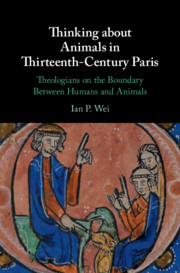 Thinking about Animals in Thirteenth-Century Paris
Thinking about Animals in Thirteenth-Century Paris 2 - The Summa Halensis and Bonaventure
Published online by Cambridge University Press: 07 August 2020
Summary
Chapter 2 explores how Franciscan theologians understood the similarities and differences between animals and humans. The Summa Halensis most frequently stressed clear difference and a strong boundary. Similarities were recognized, however, especially in relation to the corporeal. The Summa was not consistent in its approach to these similarities: sometimes they were simply natural features posing no moral or intellectual challenges, whereas on other occasions they were dangerously deceptive and symbolic of human sin. Bonaventure also accepted that in many respects the bodies of humans and animals were the same. Beyond this, however, he was not struck by much in the way of similarity. He took it for granted that humans were the most perfect animals, unique amongst animals in their possession of reason. Made in the image of God, humans related to God very differently from animals. Animals served humans, answering to their bodily and even emotional needs. Bearing symbolic meaning, they were God’s tools. Bonaventure did not see any of the similarities that underpinned more complex understandings in the work of others. For Bonaventure, the boundary between humans and animals was always clear-cut.
- Type
- Chapter
- Information
- Thinking about Animals in Thirteenth-Century ParisTheologians on the Boundary Between Humans and Animals, pp. 95 - 144Publisher: Cambridge University PressPrint publication year: 2020
